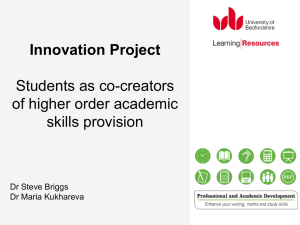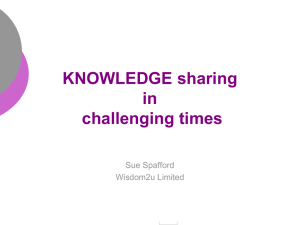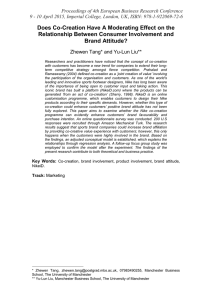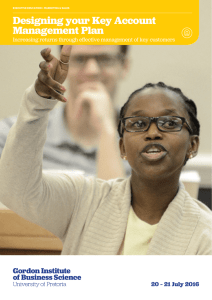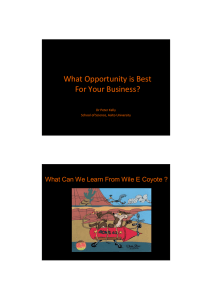Co-creating unique value with customers
advertisement
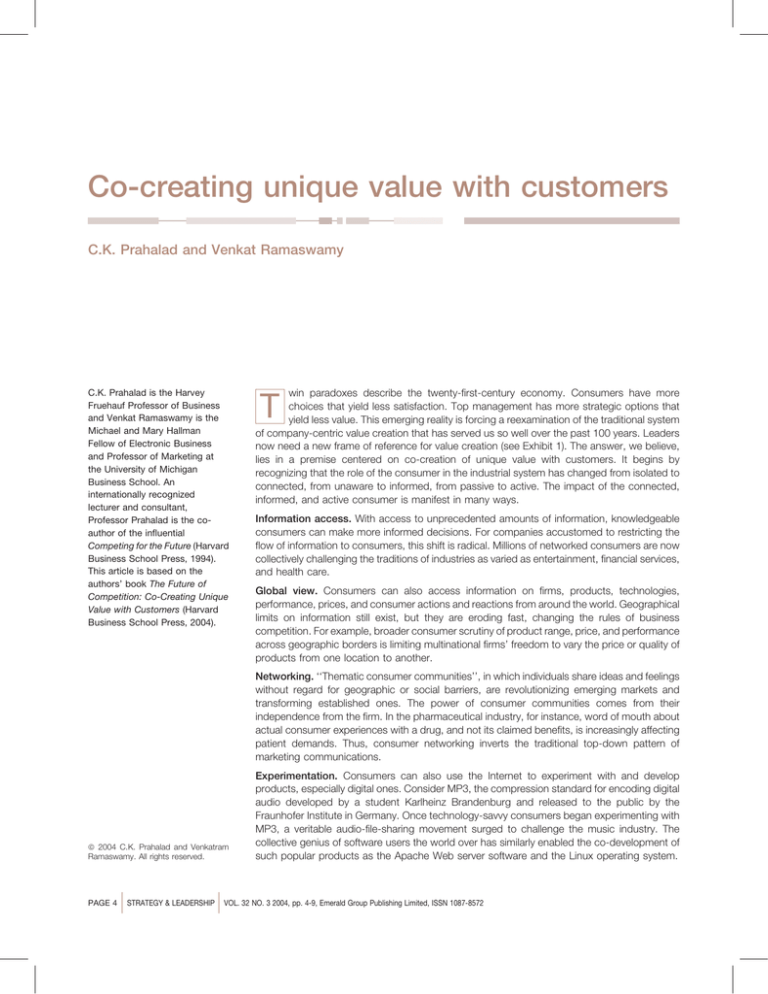
Co-creating unique value with customers C.K. Prahalad and Venkat Ramaswamy C.K. Prahalad is the Harvey Fruehauf Professor of Business and Venkat Ramaswamy is the Michael and Mary Hallman Fellow of Electronic Business and Professor of Marketing at the University of Michigan Business School. An internationally recognized lecturer and consultant, Professor Prahalad is the coauthor of the in¯uential Competing for the Future (Harvard Business School Press, 1994). This article is based on the authors' book The Future of Competition: Co-Creating Unique Value with Customers (Harvard Business School Press, 2004). T win paradoxes describe the twenty-®rst-century economy. Consumers have more choices that yield less satisfaction. Top management has more strategic options that yield less value. This emerging reality is forcing a reexamination of the traditional system of company-centric value creation that has served us so well over the past 100 years. Leaders now need a new frame of reference for value creation (see Exhibit 1). The answer, we believe, lies in a premise centered on co-creation of unique value with customers. It begins by recognizing that the role of the consumer in the industrial system has changed from isolated to connected, from unaware to informed, from passive to active. The impact of the connected, informed, and active consumer is manifest in many ways. Information access. With access to unprecedented amounts of information, knowledgeable consumers can make more informed decisions. For companies accustomed to restricting the ¯ow of information to consumers, this shift is radical. Millions of networked consumers are now collectively challenging the traditions of industries as varied as entertainment, ®nancial services, and health care. Global view. Consumers can also access information on ®rms, products, technologies, performance, prices, and consumer actions and reactions from around the world. Geographical limits on information still exist, but they are eroding fast, changing the rules of business competition. For example, broader consumer scrutiny of product range, price, and performance across geographic borders is limiting multinational ®rms' freedom to vary the price or quality of products from one location to another. Networking. ``Thematic consumer communities'', in which individuals share ideas and feelings without regard for geographic or social barriers, are revolutionizing emerging markets and transforming established ones. The power of consumer communities comes from their independence from the ®rm. In the pharmaceutical industry, for instance, word of mouth about actual consumer experiences with a drug, and not its claimed bene®ts, is increasingly affecting patient demands. Thus, consumer networking inverts the traditional top-down pattern of marketing communications. ã 2004 C.K. Prahalad and Venkatram Ramaswamy. All rights reserved. PAGE 4 | STRATEGY & LEADERSHIP | Experimentation. Consumers can also use the Internet to experiment with and develop products, especially digital ones. Consider MP3, the compression standard for encoding digital audio developed by a student Karlheinz Brandenburg and released to the public by the Fraunhofer Institute in Germany. Once technology-savvy consumers began experimenting with MP3, a veritable audio-®le-sharing movement surged to challenge the music industry. The collective genius of software users the world over has similarly enabled the co-development of such popular products as the Apache Web server software and the Linux operating system. VOL. 32 NO. 3 2004, pp. 4-9, Emerald Group Publishing Limited, ISSN 1087-8572 Exhibit 1 The new frame of reference for value creation Premise: Value is co-created by the customer and the firm The individual is central to the co-creation experience Co-creation experiences are the basis of value Implication: Customer-Firm interaction is locus of value co-creation Variety of co-creation experiences through heterogeneous interactions Personalization of the co-creation experience Manifestation: Focus on the quality of customer-firm interactions Focus on innovating experience environments Focus on experience networks Activism. As people learn, they can better discriminate when making choices; and, as they network, they embolden each other to act and speak out. Consumers increasingly provide unsolicited feedback to companies and to each other. Already, hundreds of Web sites are perpetuating consumer activism, many targeting speci®c companies and brands. America Online's AOL Watch, for example, posts complaints from former and current AOL customers. Co-creation of value What is the net result of the changing role of consumers? Companies can no longer act autonomously, designing products, developing production processes, crafting marketing messages, and controlling sales channels with little or no interference from consumers. Consumers now seek to exercise their in¯uence in every part of the business system. Armed with new tools and dissatis®ed with available choices, consumers want to interact with ®rms and thereby co-create value. The use of interaction as a basis for co-creation is at the crux of our emerging reality. In the conventional value creation process, companies and consumers had distinct roles of production and consumption. Products and services contained value, and markets exchanged this value, from the producer to the consumer. Value creation occurred outside the markets. But as we move toward co-creation this distinction disappears. Increasingly, consumers engage in the processes of both de®ning and creating value. The co-creation experience of the consumer becomes the very basis of value. The future of competition, however, lies in an altogether new approach to value creation, based on an individual-centered co-creation of value between consumers and companies. Armed with new connective tools, consumers want to interact and co-create value, not just with one ®rm but with whole communities of professionals, service providers, and other consumers. The cocreation experience depends highly on individuals. Each person's uniqueness affects the cocreation process as well as the co-creation experience. A ®rm cannot create anything of value without the engagement of individuals. Co-creation supplants the exchange process. The new frame of reference for value creation What might a new, internally consistent system based on co-creation of value look like? Managers must attend to the quality of co-creation experiences, not just to the quality of the VOL. 32 NO. 3 2004 | STRATEGY & LEADERSHIP | PAGE 5 ®rm's products and processes. Quality depends on the infrastructure for interaction between companies and consumers, oriented around the capacity to create a variety of experiences. The ®rm must ef®ciently innovate ``experience environments'' that enable a diversity of cocreation experiences. It must build a ¯exible ``experience network'' that allows individuals to co-construct and personalize their experiences. Eventually, the roles of the company and the consumer converge toward a unique co-creation experience, or an ``experience of one''. Notice what co-creation is not. It is neither the transfer nor outsourcing of activities to customers nor a marginal customization of products and services. Nor is it a scripting or staging of customer events around the ®rm's various offerings. That kind of company-customer interaction no longer satis®es most consumers today. The change that we are describing is far more fundamental. It involves the co-creation of value through personalized interactions that are meaningful and sensitive to a speci®c consumer. The co-creation experience (not the offering) is the basis of unique value for each individual. The market begins to resemble a forum organized around individuals and their co-creation experiences rather than around passive pockets of demand for the ®rm's offerings. The DART model of co-creation of value Consider the co-creation experience from a ®rm's perspective. The ®rm and its suppliers can learn more about consumers and get new ideas for design, engineering, and manufacturing. The employees ± from design engineers to carpenters ± can more deeply understand consumer aspirations, desires, motivations, behaviors, and agreeable trade-offs regarding features and functions. Through continuous dialogue, employees can relate their efforts to individual consumers. The company can reduce uncertainty in capital commitments and even spot and eliminate sources of environmental risk. But the co-creation process, demanding as it is, raises important questions for managers: J In-depth dialogue with customers is very time-intensive. How can my ®rm interact so intensely with each consumer and maintain operational ef®ciency? J Co-creation allows for an unusual degree of customer input into product design. How do I maintain consistently high standards of product quality and cede some control over design? J Transparency allows customers to interact with my ®rm in potentially intrusive ways. How much access up and down the supply chain do I allow customers? J Individual consumers are at the very heart of the co-creation experience. How do I deal with the heterogeneous demands of my customer base? J Discussing options openly gives customers a degree of control over the risks that they assume ± but not necessarily the liabilities. Where do I draw the line on acceptable risks ± and where do my legal responsibilities begin and end? J Co-creation moves the ®rm toward an individual-centered view of demand. How does demand forecasting work under such unpredictable circumstances? The building blocks of co-creation As the consumer-company interaction becomes the locus of value creation we need to understand the process of co-creation through its key building blocks: dialogue, access, risk assessment, and transparency ± the DART model of value co-creation. Dialogue. Dialogue means interactivity, engagement, and a propensity to act ± on both sides. Dialogue is more than listening to customers: it implies shared learning and communication between two equal problem solvers. Dialogue creates and maintains a loyal community. the roles of the company and the consumer `` Eventually, converge toward a unique co-creation experience, or an `experience of one'. '' PAGE 6 | STRATEGY & LEADERSHIP | VOL. 32 NO. 3 2004 Consider the customers of Cisco Systems, the leading maker of computer networking equipment. Recognizing the competence of its customer base, the company created Cisco Connections Online, which provides a suite of interactive, networked services with quick open access to Cisco's information, resources and systems. This network allows Cisco's customers to engage each other in dialogue, helping to solve one another's technical problems and enhancing the Cisco experience for everyone. Access. Access begins with information and tools. Consider Taiwan Semiconductor Manufacturing Company (TSMC), one of the world's largest and more creative semiconductor ®rms. TSMC has given its customers access to data on its manufacturing processes, design and fabrication libraries, and quality processes. Thus, as the semiconductor business becomes more software-oriented, even small software ®rms can access the knowledge base of large manufacturing facilities like TSMC, reducing the investment needed to participate effectively in the semiconductor business. Risk assessment. Risk here refers to the probability of harm to the consumer. If consumers are active co-creators, should they shoulder responsibility for risks as well? The debate about informed consent and the responsibilities of companies and consumers will likely continue for years. However, we can safely assume that consumers will increasingly participate in cocreation of value. They will insist that businesses inform them fully about risks, providing not just data but appropriate methodologies for assessing the personal and societal risk associated with products and services. Risk assessment and informed choice got a boost from the US Food and Drug Administration's decision to reintroduce Lotronex, a drug used in treating irritable bowel syndrome. After Lotronex was ®rst introduced by GlaxoSmithKline in 2000, more than 275,000 patients used it. When signi®cant side effects led to several deaths, Glaxo withdrew the drug from the market, less than ten months after its introduction. In the age of the active consumer the story didn't end here. Thousands of irritable bowel sufferers protested, demanding that the FDA re-approve the drug's usage under stricter controls. In 2002, the FDA agreed. Transparency. Companies have traditionally bene®ted from information asymmetry between the consumer and the ®rm. That asymmetry is rapidly disappearing. Firms can no longer assume opaqueness of prices, costs, and pro®t margins. And as information about products, technologies, and business systems becomes more accessible, creating new levels of transparency becomes increasingly desirable. # Robert M. Randall Consider the ongoing revolution in securities trading. Instinet, a global agency broker, uses advanced technology to enable managers of retail mutual funds, 401(k)s, IRAs, and other investment plans to negotiate the best execution price for a trade directly with each other, 24 hours a day, in more than 40 markets worldwide. The new level of transparency from the beginning of the trading cycle through post-trade cost assessment and settlement lets Instinet's customers measure the real-time costs of their trading. Such transparency of trading is now attracting individual investors, empowering many of them to trade alongside institutions. The building blocks in combination Combining the building blocks of transparency, risk assessment, access, and dialogue enables companies to better engage customers as collaborators. Transparency facilitates collaborative dialogue with consumers. Constant experimentation, coupled with access and risk assessment on both sides, can lead to new business models and functionalities designed to enable compelling co-creation experiences (see Exhibit 2). Even conventional companies such as Sony now engage in collaborative dialogues with consumers, who helped co-develop Sony's PlayStation 2. From Intel to Microsoft to Nokia, consumers are helping to shape new technology, ranging from Web-enabled devices and networking software to cellular phones. They contribute to the debate, both technically and in terms of their expectations and views of value. In so doing, they are co-shaping the future. When companies combine the four DART building blocks in different ways, they can create the following new and important capabilities: VOL. 32 NO. 3 2004 | STRATEGY & LEADERSHIP | PAGE 7 Exhibit 2 Migrating to co-creation experiences Traditional exchange Co-creation experiences Goal of interaction Extraction of economic value Co-creation of value through compelling co-creation experiences, as well as extraction of economic value Locus of interaction Once at the end of the value chain Repeatedly, anywhere, and any time in the system Company-customer relationship Transaction based Set of interactions and transactions focused on a series of co-creation experiences View of choice Variety of products and services, features and functionalities, product performance, and operating procedures Co-creation experience based on interactions across multiple channels, options, transactions, and the priceexperience relationship Pattern of Interaction between ®rm and customer Passive, ®rm-initiated, one-onone Active, initiated by either ®rm or customer, one-on-one or one-to-many Focus of quality Quality of internal processes and what companies have on offer Quality of customer-company interactions and co-creation experiences Access and transparency. Coupling access with transparency enhances the consumer's ability to make informed choices. For instance, consumers in the USA now have instant access to yield rates of investment options offered by most ®nancial services ®rms. They also have a reasonable level of transparency regarding the track record of various investment options and the quality of services offered, particularly the experiences of other customers with each ®rm. Consumers can therefore make better choices among investment options and ®rms. Dialogue and risk assessment. Combining dialogue with risk assessment enhances the ability to debate and co-develop public and private policy choices. For instance, the existence of a broad-based dialogue, more scrutiny of companies, and widely disseminated information concerning the risks associated with cigarette smoking is increasingly leading society to develop new policies as well as facilitating more informed private choices. Ongoing debates concern such questions as: Should we let tobacco ®rms market their products in ways that attract children and young teenagers? Should cigarettes be sold in vending machines or on the Internet? Should we regulate and control tobacco as strictly as alcohol or prescription drugs? Acting as citizens, individuals are signi®cantly affecting public policy even as they are making informed private decisions as consumers. Access and dialogue. Coupling access with dialogue enhances the ability to develop and maintain thematic communities. To promote the mega-hit movie Lord of the Rings: The Fellowship of the Ring New Line Cinema reached out to the more than 400 unof®cial fan Web sites, giving them insider tips, seeking their feedback on the details of the movie and offering them access to the production team. Transparency and risk assessment. Combining transparency with risk assessment enhances the ability to co-develop trust. For instance, the debate in the Firestone-Ford tire liability case centered on the amount of information Ford and/or Firestone had about risks associated with the combination of vehicles, tire pressure, and driving conditions. Should Firestone have revealed all the information about well-documented risks only, or also about the suspected but undocumented risks worth legitimate debate? Very few industries and ®rms # Robert M. Randall PAGE 8 | STRATEGY & LEADERSHIP | VOL. 32 NO. 3 2004 volunteer to disclose risks and debate them with consumer groups. Should ®nancial services ®rms have a ``consumer bill of rights''? Should investors be informed about risks in clear English (or other local language), instead of legal jargon? Consumers must trust the ®rms with which they engage in co-creation. The motto for smart companies is rapidly becoming ``When in doubt, disclose''. The new dynamics of co-creation # Robert M. Randall As we have seen, the elements of DART ± dialogue, access, risk assessment, and transparency ± are the basic building blocks of value co-creation, and managers can combine them in different ways. Although many ®rms and industries are experimenting with these elements, and the evidence of the changing nature of value creation accumulates, many companies are unable to embrace the new framework of co-creation. Why? A large part of the answer is that co-creation fundamentally challenges the traditional roles of the ®rm and the consumer. The tension manifests itself at points of interaction between the consumer and the company ± where the co-creation experience occurs, where individuals exercise choice, and where value is co-created. Points of interaction provide opportunities for collaboration and negotiation, explicit or implicit, between the consumer and the company ± as well as opportunities for those processes to break down. Discovering next practices Obviously, managers need a radically different approach for re-igniting the growth and innovation capabilities of their ®rms. We see a new frontier in value creation emerging, replete with fresh opportunities. But successful prospecting will require framing and practicing value creation in a fundamentally different way from that of the past. Recognizing that the traditional system is becoming obsolete, many ®rms are already testing new business assumptions. In the emergent economy, competition will center on personalized co-creation experiences, resulting in value that is truly unique to each individual. VOL. 32 NO. 3 2004 | STRATEGY & LEADERSHIP | PAGE 9
